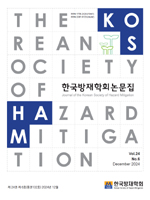우천시에 지하수위 상승과 연결관 및 맨홀 접합부의 결함은 분류식 하수관로의 유입수(Rainfall Derived Infiltration and Inflow, RDII)를 증가시켜, 계획오수량을 초과하고 하수도에서 분류식하수도월류수(Separate Sewer Overflows, SSOs) 발생을 증가시킨다. 하수도 시스템에 적절한 조치를 취하기 위해 소유역 내 RDII 유입을 확인하기 위해서는 청천 및 우천 시에 오수량을 장기적으로 모니터링하는 것이 필수적이다. 하지만 유량계 설치와 수위계 설치 비용의 차이로 인해 많은 지자체에서는 비용이 더 저렴한 수위계를 설치하고 있으며, 이는 유량 파악의 정확도를 제한하는 요소로써 작용된다. 이에 본 연구는 계측 수위 데이터를 활용하여 유량을 추정할 수 있는 환산 방법론을 수립하고 인근 계측유량자료로 이를 검증하였다. 이러한 수위-유량 환산방법은 계측기 설치의 편리성 및 예산적인 문제로 유량계 설치가 제한적인 상황에서 수위계를 설치하여 수위자료를 이용한 수위-유량 환산 방법으로써 사용이 될 것으로 기대된다.
During rainfall, the rise in groundwater levels, coupled with defects in pipe connections and manhole joints, increases Rainfall-Derived Infiltration and Inflow (RDII) in separate sewer systems. This results in exceedances of planned wastewater volumes and a surge in Separate Sewer Overflows (SSOs). To implement effective measures in the sewer system, it is crucial to monitor the long-term sewage flow under both dry and wet weather conditions to identify RDII sources within the sub-basins. However, because of the cost disparity between installing flow meters and water-level sensors, many municipalities opt for the latter, which is more economical but limits the accuracy of flow measurement. Therefore, this study developed a methodology to estimate flow rates based on measured water-level data, which were validated using adjacent flow measurement data. This water level-to-flow conversion method is expected to be utilized through the installation of water-level sensors owing to their ease of deployment, in addition to budgetary constraints that limit the use of flow meters. This approach enables the application of water-level data for flow estimation.
1. 서 론
2. 연구방법 및 분석조건
3. 적용 및 결과
4. 결 론
감사의 글
References
